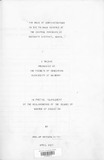| dc.description.abstract | For a professional organisation to attain its declared objectives, its leader has to have a clear perception of the professional and administrative requirements of the organisation. The personal ity of the leader also determines his effectiveness in stimulating his subordinates to attain the common goals of the organisation.
The Administrator in the Primary School directs, manages and controls al I the activities of the school . His role has not, however, been clearly defined. Perception of the role, by the role incumbents, their superiors and subordinates has been used in this study to establ ish a basis for understanding of the role.
The purpose of this study was (A) to find out:
1. The aspects of personal characteris^i cs, professional activities, and administrative responsibilities of the ideal Administrator in the Primary School perceived as (a) important and
(b) unimportant by teachers, Education Officers and Administrators in the Primary Schools.
2. The effect of professional grades, sex and position in the hierarchy of primary school administration on perception of the role.
(B) Lay a foundation for further studies in:
I. Perception of the role of Administrators in the Primary Schools by members of school committees,
2
parents, and teachers and administrators with varying lengths of service in the teaching profession.
2. Teaching effectiveness of teachers serving under Administrators in the Primary Schools who have different administrative and professional tendencies and personal characteristics.
3. The personality characteristics administrative and professional practices which contribute to effective Ieadersh i p.
The study may also help the body that employs teachers in Kenya to design rel iable and val id criteria for the selection of Administrators in the Primary Schools. It may also serve as a useful guide for Education Officers in designing suitable in-service courses for Administrators in the Primary Schools.
'v •
Lastly, findings of this study will improve perception of the role by Administrators in the Primary Schools, their superiors and subordinates and in so doing contribute to effective administration of the primary schooIs.
All the grades of trained primary school teachers in the central division of Machakos district could not be included in the study. Teachers of the S| and P^ professional teaching grades were omitted in the study because their numbers in the target population were too small to make their proportionate sampling feasible.
3
A questionnaire designed from results of a prel iminary study was used for the main study. The questionnaire was pretested in the Kaiti division of Machakos district. The subjects ranked items in three sections of the questionnaire. The items I isted under the three sections were categorised into personal characteristics/ professional activities and administrative responsibilities of the ideal Administrator in the Primary School.
Variables found likely to interfere with results of the study were identified as; chronological age and number of years individual respondents had worked in the Ministry of Education and location of schools within or outside the Machakos Township boundaries.
These were controlled by means of proportionate random
'V
samp I ing of each category of respondents.
In the analysis of data, mean scores for particular items and groups of respondents, were obtained by adding all the ranks of a particular item for a given group and dividing the sum total by the number of respondents in the group. These mean scores were used for ranking the items in order of their importance as perceived by the group.
The Spearman's rank-order test of co-relationship was used to compare the ranking of items by different groups of respondents. The relationship between rank
4
orders for items in particular sections of the questionnaire and between groups of subjects was further examined by means of the t-test. The Chi- Square test of relationship was used for ranking orders of particular items between paired groups of respondents. It is this test that revealed striking differences, between paired groups of respondents, in their perception of particular aspects of the role of the Administrator in the Primary School.
On the whole the Spearman's rank-order test of co-relationship showed no statistically significant differences in the perception of the role as represented by each of the three groups of items on the questionnaire, between Education Officers, Administrators in the Primary Schools and Teachers. The same was true for teachers of different professional grades and sexes. / A test of relationship in the perception of particular items in the questionnaire however, between different groups of respondents, revealed differences which were stat i st i caI Iy s i gn i f i cant.
Teachers and especially those of the P^ and P2 grades perceived the personal characteristics and adm inistrative responsibilities related to the development of good human relationship among members of the school staffs, as most important, while the role occupants and their superiors did not.
5
Responsibilities of the role occupant, which did not relate directly to classroom instructions were perceived as unimportant by all groups of respondents. The major recommendations made in the study were
that:
1. The main responsibilities and personal characteristics of the Administrator in the Primary School need to be spelt out clearly by the Ministry of Education for the benefit of the role incumbents, their superiors and subordinates as well as parents.
This will create ease of communication between all
the groups affected by the role and facilitate efficient primary school administration.
2. Pre-service and in-service courses for
prospective and incumbent holders of the post be
'V
mounted in teacher training institutions and in the schools to streamline the process of administering the primary schools.
3. The Human Relations Model of administration be adopted in primary schools to facilitate free exchange of educational ideas among teachers, between teachers and Administrators in the Primary Schools and between Administrators in the Primary Schools and Education Officers. This usually has the effect of increasing output among the people who practice it, and promoting the ability to innovate among teachers. | en_US |



